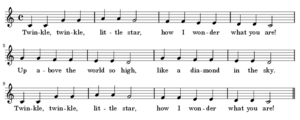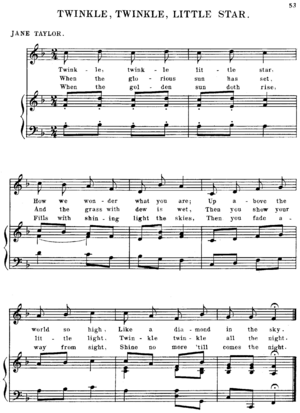Twinkle, Twinkle, Little Star facts for kids
Quick facts for kids "Twinkle, Twinkle, Little Star" |
|
|---|---|

Sheet music
|
|
| Nursery rhyme | |
| Published | 1806 |
| Lyricist(s) | Jane Taylor |
"Twinkle, Twinkle, Little Star" is a very well-known English lullaby. The words come from an early 19th-century English poem. This poem, called "The Star", was written by Jane Taylor. It first appeared in 1806 in a book titled Rhymes for the Nursery. This book was a collection of poems by Jane Taylor and her sister Ann.
The song uses the tune of an old French melody. This tune is called "Ah! vous dirai-je, maman". It was first published in 1761. Later, famous composers like Mozart used and arranged this melody. The English lyrics have five parts, called stanzas. However, most people only know the first part. This song is now in the public domain. This means anyone can use it without needing permission. Because of this, many different versions exist around the world.
How the Song Began
The English words for "Twinkle, Twinkle, Little Star" started as a poem. Jane Taylor (1783–1824) wrote it. It was published as "The Star" in 1806. This was part of Rhymes for the Nursery. Jane wrote this book with her sister Ann Taylor (1782–1866).
Here is the original poem:
Twinkle, twinkle, little star,
How I wonder what you are!
Up above the world so high,
Like a diamond in the sky.
When the blazing sun is gone,
When he nothing shines upon,
Then you show your little light,
Twinkle, twinkle, all the night.
Then the trav’ller in the dark,
Thanks you for your tiny spark,
He could not see which way to go,
If you did not twinkle so.
In the dark blue sky you keep,
And often thro’ my curtains peep,
For you never shut your eye,
Till the sun is in the sky.
‘Tis your bright and tiny spark,
Lights the trav’ller in the dark,
Tho’ I know not what you are,
Twinkle, twinkle, little star.
The poem's words were first put with the tune in 1838. This happened in a book called The Singing Master: First Class Tune Book.
Song Lyrics
The lyrics of the song are the words from Jane Taylor's poem. The first two lines of the poem are repeated. They are used as a refrain after each stanza.
For example, here is the first part of the song:
Twinkle, twinkle, little star,
How I wonder what you are!
Up above the world so high,
Like a diamond in the sky.
Twinkle, twinkle, little star,
How I wonder what you are!
The first part of the song is usually sung exactly as written. However, other parts of the song often have small changes.
Other Versions of the Song
There are other versions of the song. One example is from 1896. It appeared in Song Stories for the Kindergarten by Mildred J. Hill.
Here are some of those different words:
Twinkle, twinkle, little star,
How we wonder what you are.
Up above the world so high,
Like a diamond in the sky.
When the glorious sun has set,
And the grass with dew is wet,
Then you show your little light,
Twinkle, twinkle, all the night.
When the golden sun doth rise,
Fills with shining light the skies,
Then you fade away from sight,
Shine no more 'till comes the night.
A funny version of the song is called "Twinkle, Twinkle, Little Bat". The Mad Hatter sings it. This happens in Lewis Carroll's book Alice's Adventures in Wonderland. You can find it in chapter seven.
Another version is "Twinkle, Twinkle, Little Earth". Charles Randolph Grean, Fred Hertz, and Leonard Nimoy wrote it. It was on Nimoy's 1967 album. This album was called Leonard Nimoy Presents Mr. Spock's Music from Outer Space. In the song, Nimoy, as Spock, explains how people on other planets wish upon Earth.
The tune for the "Alphabet song" is the same as "Twinkle, Twinkle, Little Star". This means you can sing the alphabet to the same melody!
See also
 In Spanish: Campanita del lugar para niños
In Spanish: Campanita del lugar para niños


